|
|
|
Sort Order |
|
|
|
Items / Page
|
|
|
|
|
|
|
| Srl | Item |
| 1 |
ID:
123591


|
|
|
|
|
| Publication |
2013.
|
| Summary/Abstract |
We bring together a collection of papers that were presented at the inaugural event of the Asia-Europe Energy Policy Research Network (AEEPRN), held at Singapore in May 2012. The idea for creating AEEPRN was in response to the growing importance of energy in Asia and Europe's relations and to our shared belief that energy will become a more significant aspect of these relations over the forthcoming years and decades. The papers presented here cover the following themes: wind energy, biofuels, natural gas and gas pipelines, exergy and manufacturing, green energy co-operation, coal, unconventional gas and solar energy.
|
|
|
|
|
|
|
|
|
|
|
|
|
|
|
|
| 2 |
ID:
082015
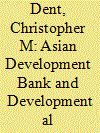

|
|
|
|
|
| Publication |
2008.
|
| Summary/Abstract |
The Asian Development Bank (adb) has made increasingly important contributions to Asia's (and particularly East Asia's) regionalism over recent years, and especially since Haruhiko Kuroda became the Bank's president in February 2005. This paper argues that the adb's role here has become more significant because of the strong 'developmental' characteristics of East Asia's new regionalism. This is not least because, as a regional development bank, the adb has a predilection for linking development, regionalism and capacity-building together when promoting regional co-operation and integration (rci) in Asia. We may refer to this as 'developmental regionalism', where rci activities are particularly orientated to enhancing the economic capacity and prospects of less developed countries with the view of strengthening their integration into the regional economy, and thereby bringing greater coherence to regional community building overall. This analysis is partly based on field research undertaken by the author involving a series of research interviews conducted amongst adb officials and with outside analysts of the organisation. It first examines the evolution of the Bank's stance and policies on rci, and the impact made by President Kuroda and the newly formed Office of Regional Integration (orei) in this regard. The main developments of East Asia's new regionalism are then outlined from finance and trade perspectives. Thereafter, an evaluation is made of the adb's contributions toward the emerging developmental regionalism in East Asia
|
|
|
|
|
|
|
|
|
|
|
|
|
|
|
|
| 3 |
ID:
049929
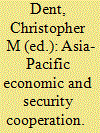

|
|
|
|
|
| Publication |
Hampshire, Palgrave Macmillan, 2003.
|
| Description |
xv, 271p.
|
| Standard Number |
1403918031
|
|
|
|
|
|
|
|
|
|
|
|
Copies: C:1/I:0,R:0,Q:0
Circulation
| Accession# | | | | | | | | | | | |
| 047366 | 337.15/DEN 047366 | Main | On Shelf | General | | | | | | | |
|
|
|
|
| 4 |
ID:
159403
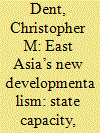

|
|
|
|
|
| Summary/Abstract |
This paper argues that to understand the relevance of developmental states in East Asia and elsewhere, we need to focus on the changing development agenda in the early twenty-first century, especially how this connects with the global challenge of climate change and thereby sustainable, low-carbon development. It combines theories on state capacity and ecological modernisation to form the ‘new developmentalism’ concept. This is applied to study revitalised and refocused forms of state capacity aimed at realising the transformative economic objectives associated with sustainable development. New developmentalism helps us understand not only current state capacity practice in a climate challenged world but also how we have moved beyond original conceptions of developmental statism. It may be understood in the wider context of the sustainable development agenda and climate interventionism. As is argued, new developmentalism is most clearly evident in East Asia but can be applied in a wider geographic sense where strong forms of developmental state capacity are exercised towards meeting transformative sustainable development goals.
|
|
|
|
|
|
|
|
|
|
|
|
|
|
|
|
| 5 |
ID:
081758
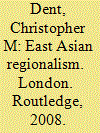

|
|
|
|
|
| Publication |
London, Routledge, 2008.
|
| Description |
xx, 320p.
|
| Standard Number |
9780415434843
|
|
|
|
|
|
|
|
|
|
|
|
Copies: C:1/I:0,R:0,Q:0
Circulation
| Accession# | | | | | | | | | | | |
| 053439 | 337.15/DEN 053439 | Main | On Shelf | General | | | | | | | |
|
|
|
|
| 6 |
ID:
094989
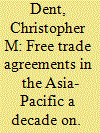

|
|
|
|
|
| Publication |
2010.
|
| Summary/Abstract |
This paper charts the growth and patterns of free trade agreement (FTA) activity in the Asia-Pacific, discussing the extent to which there has been evolution and learning in FTA practice among Asia-Pacific states, with attention to the most notable trends in technical policy content and the different ideational approaches to formulating agreements. This sets the broad context for considerations of the current and likely future paths of FTA convergence, harmonization, and transformation in the Asia-Pacific. It is argued that new options for economically rational and politically feasible bilateral FTA partnerships within the Asia-Pacific region are running out. One response has been to explore more seriously options for forming wider plurilateral and regional agreements within the Asia-Pacific. However, a number of constraints and hindrances will work against such FTA convergence and harmonization. The longer term transformation of existing, mostly bilateral FTAs into different or expanded types of agreement has stronger prospects.
|
|
|
|
|
|
|
|
|
|
|
|
|
|
|
|
| 7 |
ID:
080570


|
|
|
|
|
| Publication |
2007.
|
| Summary/Abstract |
In 2004 and 2006, proposals were made at APEC summits to establish a Free Trade Area of the Asia-Pacific (FTAAP). This was an essentially a reworking of an idea first raised in the mid-1960s to create a Pacific Free Trade Area, or PAFTA. Although the PAFTA initiative never advanced, it helped lay the first organizational foundations for regional economic community building in the Asia-Pacific. The recent FTAAP proposal thus brings us full circle to the antecedent origins of APEC itself. If realized, an FTAAP would also create a free trade zone that would encircle the Pacific Rim economy and thereby subsume the region's now large number of bilateral and sub-regional free trade agreements (FTAs) into one unified agreement. Yet there are many inherent problems with establishing an FTAAP. These broadly relate to deconstructing the preferentialism of existing bilateral and sub-regional FTAs, achieving a consensus on the technical policy content and ideational principles on which an FTAAP would be based, and addressing various geopolitical issues such as reconciling the formation of a pan-regional Asia-Pacific FTA with an already fragile multilateral trading system. Growing interest in a 'rival' East Asia Free Trade Area project presents another geopolitical challenge. In considering these and other questions, it is concluded that many obstacles will remain in the path to realizing an FTAAP, and that this may not actually be a desirable objective to pursue for some time yet
|
|
|
|
|
|
|
|
|
|
|
|
|
|
|
|
| 8 |
ID:
086430
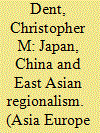

|
|
|
|
|
| Publication |
2009.
|
| Summary/Abstract |
East Asia is becoming an increasingly coherent regional entity in political economic terms, and remains a region of enormous geo-strategic significance for the European Union. Europe's links with China and Japan are especially important, and moreover these two countries are looking in various ways to exercise various forms of regional leadership in East Asia. This has critical implications for the EU's relations with the East Asia region generally, and also for the wider international system. Similar and related impacts maybe construed from deepening East Asian regionalism, involving processes where both Japan and China play vitally important roles. The analysis presented here examines the both micro and macro level developments in East Asian regionalism, and issues relating to Japan, China and regional leadership. It concludes by discusses the implications of these matters for the European Union, and recommends that the EU should pay particularly close attention to emergent exercises of regional leadership in East Asia, most likely to be performed by Japan and/or China.
|
|
|
|
|
|
|
|
|
|
|
|
|
|
|
|
| 9 |
ID:
067774
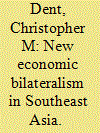

|
|
|
| 10 |
ID:
123988
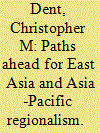

|
|
|
|
|
| Publication |
2013.
|
| Summary/Abstract |
East Asia and the Asia-Pacific are core components of the global economy, and there have been important recent developments in the regionalism of both regions. After the 1997-1998 financial crisis, East Asian countries initiated more exclusive regional cooperation and integration ventures mainly through ASEAN Plus Three, but lately this process has stumbled. The Asia-Pacific Economic Cooperation (APEC) forum has also failed to make substantial progress.
Attention has instead increasingly turned to free trade agreements (FTAs), yet these have hitherto been overwhelmingly bilateral in nature. There are still only a few truly regional FTAs in East Asia and the Asia-Pacific - and these are on a sub-regional scale. However, various frustrations over the messy and fractious pattern of heterogeneous bilateral agreements led to the recent initiation of 'grand regional' FTA talks.
The Trans-Pacific Partnership (TPP) is an Asia-Pacific-based, United States-led project while the Regional Comprehensive Economic Partnership (RCEP) is an East Asia-centred project. Each contains highly diverse memberships and the successful conclusion of TPP and RCEP talks is not assured.
It is argued that, if negotiated, the RCEP is more likely to advance meaningful and effective regionalism than the TPP due to the former ascribing more importance to regional community-building. Furthermore, bilateral FTAs already in force may over the long term transform into more comprehensive economic agreements that address new regional and global challenges such as energy security and climate change.
|
|
|
|
|
|
|
|
|
|
|
|
|
|
|
|
| 11 |
ID:
118574
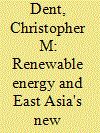

|
|
|
|
|
| Publication |
2012.
|
| Summary/Abstract |
East Asia's renewable energy (RE) sector has grown faster than any other region's since the mid-2000s. It is argued that renewables formed an integral part of the region's new industrial policies and new developmentalism, which are founded on new configured forms of state capacity shaped in response to various challenges, primarily climate change, energy security, globalisation and global neo-liberalism. By studying the recent progress of East Asia's RE sector, we gain useful insights into these key developments in East Asia's political economy and the region's prospects for transition towards low carbon development. This analysis considers how and why different approaches to RE policy emerged in East Asia, to what extent the promotion and expansion of East Asia's RE sector is part of a new industrial policy paradigm and new developmentalism, and what the study of East Asian policies on promoting renewable energy can tell us about the region's broader approach to low carbon development. Although the promotion of renewable energy has been a fundamental part of East Asia's recent macro-development plans and new developmentalism generally, these same plans suggest that East Asian states will simultaneously continue to significantly promote high carbon and ecologically damaging industrial activities, thus undermining the low carbon credentials of East Asia's new developmentalism. The path to meaningful low carbon development will be very long and will take many decades to achieve. However, it is contended that by maintaining and improving their various forms of state capacity over time, the East Asian states will be well positioned to sustain the significant growth of their renewable energy sectors and thereby further strengthen the low carbon development orientation of their new industrial policies, macro-development plans and strategic economic thinking.
|
|
|
|
|
|
|
|
|
|
|
|
|
|
|
|
| 12 |
ID:
104129
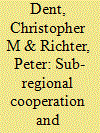

|
|
|
|
|
| Publication |
2011.
|
| Summary/Abstract |
The Brunei-Indonesia-Malaysia-Philippines East ASEAN Growth Area (BIMP-EAGA) is one of a number of sub-regional "growth polygons" in Southeast Asia that was established in the early 1990s to help accelerate the process of regional integration among the member states of the Association of Southeast Asian Nations (ASEAN). However, these sub-regional zones include the less developed parts of Southeast Asia, and therefore face significant developmental challenges. This paper seeks to understand how BIMP-EAGA has addressed these challenges in accordance with the principles of developmental regionalism; that is, activities that are particularly oriented to enhancing the economic capacity and prospects of lesser-developed countries with a view to strengthening their integration into the regional economy, and thereby bringing greater coherence to overall regional community building. This article examines how BIMP-EAGA has pursued developmental regionalism through various initiatives and measures aimed at enhancing inter-related development capacities: technocratic, institutional, industrial, infrastructural, human and sustainable development. There have been successes but also failures in BIMP-EAGA, as evidenced by the persistent lack of progress in achieving substantial sub-regional development cooperation. This paper discusses the reasons for these outcomes, and makes a number of recommendations to give BIMP-EAGA new direction and purpose.
|
|
|
|
|
|
|
|
|
|
|
|
|
|
|
|
| 13 |
ID:
100976
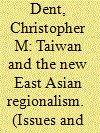

|
|
|
| 14 |
ID:
064554
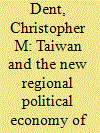

|
|
|
| 15 |
ID:
194352


|
|
|
|
|
| Summary/Abstract |
In a global economy and system increasingly defined by new developments and complexities in trade, whose rules and regulations govern that trade matter. The UK has embarked on a new post-Brexit trade policy, signing its first wholly new free trade agreements (FTAs) with Australia and New Zealand. It is also in negotiations to join the Comprehensive and Progressive Trans-Pacific Partnership (CPTPP) as part of the UK’s aspirations to become an integral part of the Asia-Pacific trading community. This study’s research and text analysis on the UK’s bilateral FTAs with Australia and New Zealand reveals high levels of similarity with two larger regional agreements heavily imprinted with US trade regulatory norms—this being the CPTPP itself and the United States–Mexico–Canada Agreement (USMCA). The UK’s revealed willingness to strongly align itself with US trade regulatory norms has important implications for the Asia-Pacific. It also raises some key issues on what kind of trade partner the region might expect a post-Brexit ‘Global Britain’ to become, and how the UK’s deeper planned engagement with the Asia-Pacific could affect its strategic dynamics. This could significantly depend on how closely the UK is pulled over time into the US’ trade regulatory orbit.
|
|
|
|
|
|
|
|
|
|
|
|
|
|
|
|
| 16 |
ID:
121959
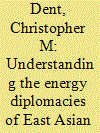

|
|
|
|
|
| Publication |
2013.
|
| Summary/Abstract |
Energy security is one of the major global challenges of the twenty-first century. Intensifying competition for ever scarcer forms of conventional energy resources is causing significant tensions in the international system. East Asia will have a more profound impact on global energy security than any other region as its burgeoning demand for energy fuels, spurred principally by China, is expected to continue growing at over twice the world average in the next few decades. This paper examines the reasons why we may expect the energy diplomacies of East Asian states to become an increasingly salient feature of East Asian states' foreign policy and international relations in the foreseeable future, and thereby significantly shape the nature of the region's international political economy. It presents a framework of energy diplomacy analysis in order to better understand how East Asian states are formulating their energy diplomacy strategies and actions. The four prime elements of this framework comprise: empirical perspectives and generic task-oriented terms; agential influences on the formation and organization of energy diplomacy practice; the energy-development nexus; and transaction mechanisms of energy diplomacy. The main conclusions are first, mercantilist approaches to energy diplomacy will persist but continue to gradually give way to market institutionalism; second, energy diplomacy will become increasingly linked to other forms of diplomacy, such as trade, environment and development assistance; third, we may expect East Asian states to afford greater priority to multilateral energy co-operation both regionally and in a wider international or global sense as energy security interdependencies deepen; and fourth, East Asia's growing reliance on sourcing energy fuels from outside the region will make it more dependent on stable international energy markets-these markets are becoming increasingly internationalized and globalized, which will broaden the future options of East Asian states developing new international energy partnerships.
|
|
|
|
|
|
|
|
|
|
|
|
|
|
|
|
| 17 |
ID:
123592
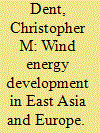

|
|
|
|
|
| Publication |
2013.
|
| Summary/Abstract |
Over the last decade, wind energy has emerged as the most important non-hydro renewables sector, contributing significantly to global efforts on developing low-carbon energy systems. In terms of grid electricity generation, its power output has increased almost 16-fold since 2000 and currently produces around 3 times that of solar photovoltaic, 4 times more than biomass and 20 times more than geothermal installations globally. Europe and East Asia have been at the forefront of wind energy development, together accounting for almost 70 % of total installed capacity and most of the world's largest wind turbine producers. This paper begins by providing an overview of historic and recent developments in wind energy and then discusses key techno-innovation, production and internationalisation issues before looking at policy approaches taken by European and East Asian countries to renewable energy generally and wind energy more specifically. Finally, obstacles to the future development of the wind energy sector are discussed.
|
|
|
|
|
|
|
|
|
|
|
|
|
|
|
|
|
|
|
|
|